17 Jun – 14 Aug 2022
Start Somewhere Else: Works from the Collection
-
Marian Penner Bancroft
ArtistMarian Penner Bancroft (Canadian, b. 1947) is a Vancouver-based photographer and visual artist and Professor Emerita at Emily Carr University of Art and Design. While multifaceted and ever evolving, her practice has largely centered on the intersection between socio-cultural history, personal memory and photography. More recently, Bancroft’s work has focused on investigating the relationship between photographic images, history, music and mapping strategies in terms of their capacity to represent landscapes. Bancroft studied at UBC, the Vancouver School of Art and Ryerson Polytechnical Institute. Bancroft has exhibited extensively in solo exhibitions at the Vancouver Art Gallery, Catriona Jeffries Gallery, Republic Gallery, Galerie de l’UQAM, Or Gallery and Presentation House Gallery. She has been featured in group exhibitions including C. 1983 (2012) at Presentation House Gallery, North Vancouver; SLOW: Relations + Practices (2010) at Centre A, Vancouver and Wack: Art And The Feminist Revolution (2008) at the Vancouver Art Gallery. Bancroft has won numerous awards including the Audain Prize for Lifetime Achievement in the Visual Arts (2012), the Higashikawa Award for photographic Achievements (2018) and the Canada Council Paris Studio Residency Award (2005).
Read More
-
Rebecca Belmore
ArtistRebecca Belmore (Lac Seul First Nation (Anishinaabe), b. 1960) is a multidisciplinary visual artist. Belmore is widely recognized for her performance, photographic and sculptural work that makes connections between bodies, land and language with ongoing social and political realities faced by Indigenous communities. Questions of authority, narrative and truth resonate throughout her practice. In 2005 she was the first Indigenous woman to represent Canada in the Venice Biennale. Her work has appeared extensively in exhibitions both nationally and internationally, and her solo exhibitions include the Belkin Art Gallery, Art Gallery of Ontario, and Justina M. Barnick Gallery. Belmore has received numerous honours and awards, including the Hnatyshyn Award (2009), the Governor General’s Award for Visual and Media Arts (2013) and Gershon Iskowitz Prize (2016). She attended the Ontario College of Art and Design in Toronto, and has received honourary doctorates from OCAD University (2005), Emily Carr University of Art and Design (2018), and NSCAD University (2019).
Read More
-
Judith Copithorne
ArtistJudith Copithorne (Canadian, b. 1939) is one of Vancouver’s most influential concrete poets. Copithorne’s “poem-drawings” employ abstract lines and words to create a visual work of art, a reference to concrete poetry’s emphasis on typographical effects rather than verbal importance. Her work from the 1960s and 1970s engages with meditation and community, referring to mandalas, maps and yogic texts. Her work has expanded, including explorations into digital means of composing poem-drawings, creating crisp and over saturated drawings with texts. Copithorne’s practice in concrete poetry and other forms of experimental writing led to her social and artistic participation at Sound Gallery, Motion Studio and Intermedia in Vancouver. She worked alongside many artist-poets, taking part in Downtown Vancouver Poets, an informal group imagined as a counterpoint to those involved at TISH, a Canadian poetry newsletter run by student-poets at the University of British Columbia in 1961. Copithorne has an extensive list of publications including over 40 books, chapbooks and ephemeral items.
Read More
-
Audrey Capel Doray
ArtistAudrey Capel Doray (b. 1931) is a Canadian artist working in a variety of mediums—painting, printmaking, electronic art, murals and films. She received a BFA from McGill University and went on to study at Atelier 17 in Paris and at the Central School of Art in London. After moving to Vancouver in 1957, Capel Doray taught at the Vancouver School of Art (now Emily Carr University) from 1959 to 1961. In 1962, Capel Doray joined Alvin Balkind and Abraham Rogatnick’s New Design Gallery, an influential art space that presented live theatre, visual art, films, concerts, lectures and poetry readings. Capel Doray was a major figure in the Vancouver scene of the 1960s and was engaged with experiments in new media, interactive and kinetic art and electronic communications. She and her late husband, Victor Doray, were community leaders, involving themselves in Intermedia and other experimental formations influenced by philosopher Marshall McLuhan. A recipient of four Canada Council awards, Capel Doray’s work is held in numerous private and public collections, both nationally and internationally. Her work is described in North American Women Artists of the Twentieth Century as combining “robust social criticism with her own interpretation of humanist theory” and dealing with pop art and the feminist archetype, themes of “perpetual motion and endless transition”, and the interplay of sound and light.
Read More
-
Whess Harman
ArtistWhess Harman (Carrier Wit’at, b. 1974) is an artist whose multidisciplinary practice encompasses beadwork, illustration, text, poetry and curation. Through humour and carefully negotiated cynicism, their work navigates “undiagnosed attention deficit disorder, colonial bullshit and queer melancholy” as it is experienced through their identity as a mixed-race, transgender artist. Their practice emphasizes the importance of community-engaged work and the need to prioritize accessible and safe spaces. In January 2021, Harman became the curator of grunt gallery in Vancouver. They received their BFA from Emily Carr University of Art and Design (2014). Solo exhibitions include chew the bones, they’re soft at Open Space, Victoria (2022) and Lossy: How to Save File for Future Transmission at the Fina Gallery at the University of British Columbia Okanagan, Kelowna (2021). Group exhibitions include Sensing of the Wound at the Or Gallery, Vancouver (2022); Nch’u7mut cheshá7 temíxw/Giving Back to Mother Earth at the Talking Stick Festival, Vancouver (2021); gathered together at the Wall-to-Wall Mural Festival, Winnipeg (2021); Distortions and Echo at the Vancouver Art Gallery (2021); Exploring Care at the Campbell River Art Gallery (2021); On Beaded Ground at the Legacy Art Gallery, Victoria (2021); cause to become at the School of Art, Winnipeg (2021); and queersphere at InterAccess, Toronto (2021) among others. Their curatorial projects include Together Apart, Queer Indigeneities at grunt gallery (2019); Spark Talks at grunt gallery (2018) and The Tribe Has Spoken at Skwachay’s Lodge, Vancouver (2018).
Read More
-
Brian Jungen
ArtistBrian Jungen (Dane-zaa, b.1970) is a visual artist of Dane-zaa and Swiss-German ancestry. In his artistic practice, Jungen addresses complex relationships between Indigenous and global cultures through the juxtaposition of cultural signifiers. Jungen incorporates visual elements from both western consumer culture and motifs drawn from Indigenous traditions, a reflection of his mixed heritage. This hybridization of identities—present through most of Jungen’s oeuvre, from small-scale drawings to large-scale sculptures and installations— queries relationships of aesthetic, economic and social power at personal and global scales. Jungen has participated in group exhibitions including Baja to Vancouver: The West Coast in Contemporary Art, Museum of Contemporary Art San Diego (2004) and What Water Knows, The Land Remembers, Toronto Biennial of Art (2022). Jungen has held solo exhibitions with Or Gallery, Vancouver (2000); documenta 13 (in collaboration with Duane Linklater), Kassel, Germany (2013), the Art Gallery of Ontario, Toronto (2019) and the Hammer Museum, Los Angeles (2021). He currently lives and works in the North Okanagan region of BC.
Read More
-
Rita Letendre
ArtistRita Letendre (Abenaki/Quedecoise, 1928-2021) was an internationally renowned painter, printmaker and muralist. She began her career in the 1950s in Montreal, working in abstraction and associating with Les Automatistes and Les Plasticiens, often being the only woman in their group exhibitions. Her abstract works employ vibrant oils which suggest movement through repeated geometric shapes. Letendre gradually moved from the looser Automatiste style to the more geometric, hard-edged techniques employed by the Plasticiens. In 1948, Letendre enrolled at the École des Beaux-Arts in Montreal, but did not agree with their strong emphasis on traditional figurative art, which brought her into conversation with Les Automatistes and Les Plasticiens. She caught the attention of the wider Canadian abstract art scene in 1954 when she was included in the Automatiste exhibition La matière chante in 1954. Letendre visited California in the mid-1960s, where she attended the Tamarind Lithography Workshop and produced her first prints in 1965. In 2005, she received the Order of Canada and in 2010, the Governor General’s Award in Visual and Media Arts.
Read More
-
Ken Lum
ArtistKen Lum (Canadian, b. 1956) is an artist with an extensive international exhibition record. He co-founded and served as the founding editor of the Yishu Journal of Contemporary Chinese Art. A prolific writer, he has published numerous essays. He has delivered keynote addresses at various prestigious events, including the 2024 Duldig Sculpture Lecture in Melbourne, the 2022 International Association of Empirical Aesthetics Congress in Philadelphia, and the 2010 World Museums Conference in Shanghai. His writings are compiled in Everything is Relevant: Writings on Art and Life 1991 – 2018, published by Concordia University Press in 2020. Lum has completed many public art commissions in cities such as Rotterdam, Leiden, St. Louis, Toronto, St. Moritz, and Vienna. He co-curated exhibitions, including Shanghai Modern: 1919 – 1945, Sharjah Biennial 7, and Monument Lab: Creative Speculations for Philadelphia. Additionally, Lum is a co-founder and serves as the Senior Curatorial Advisor to Monument Lab, a public art and history think tank in Philadelphia. He holds the Marilyn Jordan Taylor Presidential Professorship at the University of Pennsylvania.
Read More
-
Salar Mameni
ArtistSalar Mameni (Canadian, b.1977) is an interdisciplinary artist, curator and art historian specializing in transnational visual culture in the Arab/Muslim world. Their research areas include racial discourses, feminism and gender politics, militarism, extractive economies, oil cultures and the anthropocene. Mameni’s newspaper drawings replicate the everyday, an acknowledgement of the mass consumption of media but also of the tedious labour involved in the manual reproduction of mass media. Mameni received a BFA from Emily Carr University of Art and Design, an MFA from the University of British Columbia and a PhD in Art History from the University of California, San Diego. They have written for Signs, Women & Performance, Al-Raida Journal, Fuse Magazine, Fillip Review and Canadian Art Journal. Their work has been exhibited in group exhibitions at Atelier Gallery, Vancouver (2003); the Vancouver Art Gallery (2003, 2012); YYZ Artists’ Outlet, Toronto (2008) and Western Front, Vancouver (2008). Mameni is Assistant Professor in the Department of Ethnic Studies, University of California, Berkeley. They are currently working on their first book, Crude: The Art of Living in the Terracene.
Read More
-
Melinda Mollineaux
ArtistMelinda Mollineaux (Canadian, b. 1964) is a visual artist who investigates Blackness, the diaspora and visibility in her artistic practice. Born in London, England, her parents migrated from Trinidad to Britain in the 1950s and settled in Lethbridge, AB in 1981. Mollineaux explores identities formed in the Black diaspora, bringing forth its invisible qualities through pinhole photography and ceramics. Focused on time and presence, she foregrounds her own body through the process of slow photography to call attention to the erasure of Black people within Canadian cultural discourses. Mollineaux received a BA from Simon Fraser University and an MFA in photography from the University of Victoria. She was active in Vancouver’s artist-run centres and was co-editor of Boo Magazine in the 1990s. Mollineaux works at the Canada Council for the Arts as a Policy and Planning Officer, prior to which she held roles as Program Officer and Equity Coordinator; in the latter role, Mollineaux oversaw cultural diversity-related policies and initiatives, ensuring visible minority artists and organizations have equal access to the Council’s funding programs.
Read More
-
Marianne Nicolson
ArtistMarianne Nicolson (Kwakwa̱ka̱’wakw, Musga̱maḵw Dzawada̱’enux̱w First Nations, b. 1969) is an artist and activist of the Musga̱maḵw Dzawada̱’enux̱w Nations who are part of the Kwakwa̱ka̱’wakw (Kwak’wala speaking peoples) of the Northwest Coast. She is trained in both traditional Kwakwa̱ka̱’wakw forms and culture and contemporary gallery and museum-based practice. Her practice is multi-disciplinary, encompassing photography, painting, carving, video, installation, monumental public art, writing and speaking. She works as a Kwakwaka’wakw cultural researcher and historian, as well as an advocate for Indigenous land rights. She holds a BFA from the Emily Carr University of Art and Design (1996), an MFA (2000), MA in Linguistics and Anthropology (2005) and PhD in Linguistics and Anthropology with a focus on space as expressed in the Kwak’wala language (2013) all from the University of Victoria. Solo exhibitions include the Art Gallery of Greater Victoria (2008); Artspeak, Vancouver (2006); Esquimalt Municipal Hall (2004); Thunder Bay Art Gallery (2002); National Indian Art Centre, Hull (2001); Campbell River Public Art Gallery (2000) and Or Gallery, Vancouver (1992). Group exhibitions include the 17th Biennale of Sydney (2020); the Morris and Helen Belkin Art Gallery, Vancouver (2020); the Vancouver Art Gallery (2019-20); the National Gallery of Canada, Ottawa (2018-19) and the National Museum of the American Indian, New York (2017-19), among others. Major monumental public artworks are situated in her home territory of the Musga̱maḵw Dzawada̱’enux̱w First Nation, Vancouver International Airport, the Canadian Embassy in Amman, Jordan and the Canadian Embassy in Paris, France.
Following Nicolson’s Hexsa’a̱m: To Be Here Always, a 2019 project with the Belkin that functioned as research, material, media, testimony and ceremony to challenge the western concept that the power of art as limited to the symbolic, This Is An Emergency Broadcast (2023) is another moment to amplify Indigenous tradition.
Read More
-
Jeneen Frei Njootli
ArtistJeneen Frei Njootli (Vuntut Gwitchin, b. 1988) is a 2SQ artist currently based in their home territory of Old Crow, YT. Their work with knowledge keepers has guided their interdisciplinary practice which is grounded in affirming Indigenous sovereignty, decolonization and considering the ways in which images are created, shared and embodied. Through an interdisciplinary practice encompassing performance, photography, sound, textiles, workshops and collaboration, they seek to deconstruct the history of materials and to investigate their relationship to the land, trade, ceremony and politics of Indigenous representation. Njootli received an MFA from the University of British Columbia (2017) and a BFA from Emily Carr University of Art and Design (2012). Solo exhibitions include the PLATFORM Centre, Winnipeg (2020), Remai Modern, Saskatoon (2019), Contemporary Art Gallery, Vancouver (2018); Artspace, Vancouver (2018); Southern Alberta Art Gallery, Lethbridge (2017) and Definitely Superior Art Gallery, Thunder Bay (2017). Their work has been exhibited in group exhibitions including at the New Museum Triennial, New York (2021), the Anchorage Museum (2021), the Vancouver Art Gallery (2020) and the National Gallery of Canada, Ottawa (2018-19). Njootli was shortlisted for the Sobey Art Award (2018) and received the Contemporary Art Society Vancouver Artist Prize (2017). They are a founding member of the ReMatriate Collective (created in 2015), which engages social media as a way of bringing Indigenous women together through art.
Read More
-
Jerry Pethick
ArtistJerry Pethick (Canadian, 1935-2003) was a visual artist who bridged artistic and scientific fields through an immersive study of optics and perception. Pethick’s lifelong interest in technology and the possibilities of visual perception led to experiments with unconventional materials in his art practice such as plastics and lenticular lenses. A key strategy in his experimentation was obscuring perspective, either through lenses or sculptural assemblages, which was reflective of his critique of modernism and linear progress. Pethick’s work gained popularity during the 1960s and 1970s, as it aligned with many counterculture concepts including alternative experiences of reality, op-art and mysticism. A graduate of Chelsea Polytechnic and the Royal College of Art in London, UK, Pethick’s work has been exhibited internationally, including shows at the Vancouver Art Gallery (1979, 1984), the National Gallery of Canada, Ottawa (1989), Centre International d’Art Contemporain Montréal (1992) and the Toronto Sculpture Garden (1993). A major survey of his work was exhibited posthumously at the Vancouver Art Gallery in 2015.
Read More
-
ᐃᓄᒡᔪᐊᕐᔪᒃ ᐳᓪᓚᑦ Innukjuakju Pudlat
Artistᐃᓄᒡᔪᐊᕐᔪᒃ ᐳᓪᓚᑦ Innukjuakju Pudlat (Inuk, 1913-1972) is a visual artist who grew up in the Kiaktuuq region of Nunavut. After marrying artist Pudlo Pudlat, she moved to Amadjuak and later to Kinngait (formerly Cape Dorset). Pudlat worked primarily in drawing and printmaking to depict histories, contemporary realities and cultural knowledge from the worldviews of the Inuit living in Baffin Island. She produced numerous textile works alongside a group of Inuit artists and printmakers as part of Kinngait Studios (formerly known as the West Baffin Eskimo Co-operative) from the 1950s to 1960s. In 1959, five of her prints were included in the inaugural Cape Dorset Print Collection and in 1983, one of her prints was featured on the cover of a UNICEF greeting card. Her work has been exhibited at the Textile Museum of Canada, Toronto (2019-22); McMichael Art Gallery, Kleinburg (2013); Memorial Art Gallery, Rochester (2009-10); Arctic Artistry in Hastings-on-Hudson (1990); Glenbow Museum, Calgary (1990); University of Michigan, Ann Arbor (1987-89); Macdonald Stewart Art Centre, Guelph (1987); Simon Fraser University Gallery, Burnaby (1971) and Konstframjandet, Stockholm (1967), among others. Her work resides in the collections of the National Gallery of Canada, Ottawa; the Museum of History, Hull; the Glenbow Museum, Calgary; West Baffin Eskimo Cooperative, Kinngait; Laurentian University Museum and Arts Centre, Sudbury; Winnipeg Art Gallery; Royal Ontario Museum, Toronto, among many others.
Read More
-
Skeena Reece
ArtistSkeena Reece (Tsimshian/Gitksan/Cree, b. 1974) is an artist based on the West Coast of British Columbia. Her installation and performance work has garnered national and international attention, most notably for Raven: On the Colonial Fleet (2010) presented at the 2010 Sydney Biennale as part of the group exhibition Beat Nation. Her multi-disciplinary practice includes performance art, spoken word, humour, “sacred clowning,” writing, singing, songwriting, video and visual art. She studied media arts at Emily Carr University of Art and Design, and was the recipient of the British Columbia Award for Excellence in the Arts (2012), the VIVA Award (2014) and the Hnatyshyn Award (2017). For Savage (2010), Reece won a Genie Award for Best Acting in a Short Film and the film won a Golden Sheaf Award for Best Multicultural Film, ReelWorld Outstanding Canadian Short Film, Leo Awards for Best Actress and Best Editing. Solo exhibitions include Surrounded at the Morris and Helen Belkin Art Gallery (2019); Touch Me at the Comox Valley Art Gallery, Courtenay, BC (2018); Moss at Oboro Gallery, Montréal (2017) and The Sacred Clown & Other Strangers at Urban Shaman Contemporary Aboriginal Art, Winnipeg (2015). Group Exhibitions include Red on Red: Indigeneity, Labour, Value at the University of British Columbia, Vancouver (2022); Women & Masks: An Arts-Based Research Conference at Boston University (2021-22), Interior Infinite at the Polygon Gallery, North Vancouver (2021); Àbadakone at the National Gallery of Canada, Ottawa (2018-2019) and Sweetgrass and Honey at Plug In ICA, Winnipeg (2018), among others.
Read More
-
Krista Belle Stewart
Curator, ArtistKrista Belle Stewart (Syilx Nation, b. 1979) is a visual artist and citizen of the Syilx Nation currently based in Berlin and Vienna. Stewart works primarily with video, photography, sculpture and performance, drawing out personal and political narratives inherent in archival materials while questioning their articulation in institutional histories. Her work has been shown at solo exhibitions at Goethe Institute Seattle (2021); MOCA, Toronto (2020); Nanaimo Art Gallery (2019); Kunstlerhaus Bethanien, Berlin (2019); Teck Gallery at Simon Fraser University, Vancouver (2018) and Mercer Union as part of the 28th Images Festival, Toronto (2015). Group exhibitions include Kunstverein in Hamburg (2021); Eva International, Limerick (2021); Bonniers Konsthall, Stockholm (2020); CTM Festival, Berlin (2020); ISCP, Brooklyn (2017); Musée d’Art Contemporain, Montreal (2017) and Vancouver Art Gallery (2016). Screenings and performances include Haus der Kulturen der Welt, Berlin (2022 and 2017); MoMA’s Doc Fortnight, Manhattan (2021); UnionDocs, Brooklyn (2019); 221A, Vancouver (2018) and Plug-In Institute, Winnipeg (2017). Stewart’s work is currently part of Galerie Barbara Thumm’s online platform New Viewings. She is an MFA graduate from the Milton Avery Graduate School of the Arts at Bard College, Annandale-On-Hudson, NY and is presently a PhD in Practice candidate at the Academy of Fine Arts in Vienna, Austria.
Read More
-
Althea Thauberger
ArtistThauberger is an artist and filmmaker and an Associate Professor of Visual Art at the University of British Columbia. Her artistic work involves collaborative research and is primarily concerned with the relationship between community narratives and geopolitical histories. Thauberger has produced and exhibited her work internationally including recent exhibitions at the Contemporary Art Gallery in Vancouver and the Kaunas Biennial in Lithuania.
Read More
-
Joyce Wieland
ArtistJoyce Wieland (Canadian, 1931-1998) was an artist and experimental filmmaker celebrated for bringing feminist concerns to the forefront of Canadian art in the 1960s and 1970s. Drawing inspiration from Canadian history, politics and ecology, Wieland’s career as an artist began in painting with her first solo exhibition in 1960 at the Isaacs Gallery in Toronto. After relocating to New York in 1962, she became widely known for experimental video work, including her innovative approach to gender and landscape in The Far Shore (1976), a feminist re-imagining of the story of the Canadian painter Tom Thomson. Following her return to Canada in 1971, Wieland’s work began to challenge modernist ideals by incorporating traditionally feminine materials, such as sewing, knitting, rug hooking and embroidery. In 1971, Wieland opened True Patriot Love, the first retrospective for a living Canadian woman artist at the National Gallery of Canada. In 1987, the Art Gallery of Ontario mounted a major travelling exhibition of Wieland’s work, which was also its first retrospective of a living Canadian woman artist. Joyce Wieland was a member of the Royal Canadian Academy of Arts and was made an Officer of the Order of Canada in 1982.
Read More
-
Lawrence Paul Yuxweluptun Lets’lo:tseltun
ArtistLawrence Paul Yuxweluptun Lets’lo:tseltun (Cowichan/Syilx, b. 1957) is a Vancouver-based visual artist and activist of Cowichan (Hul’q’umi’num Coast Salish) and Okanagan (Syilx) descent. Born in Kamloops, BC, he attended the Kamloops Indian Residential School as a child, but spent most of his adolescence in the Vancouver area. He documents and promotes change in contemporary Indigenous history through his paintings using Coast Salish cosmology, Northwest Coast formal design elements and the western landscape tradition. His work explores political, environmental and cultural issues and his own personal and socio-political experiences enhance this practice of documentation. Yuxweluptun has exhibited nationally and internationally in solo and group shows, including the Belkin’s inaugural 1995 exhibition Lawrence Paul Yuxweluptun: Born to Live and Die on Your Colonialist Reservations, the Museum of Anthropology’s Lawrence Paul Yuxweluptun: Unceded Territories (2016), the National Gallery of Canada’s Sakahán: International Indigenous Art (2013), and the Services Culturels de l’Ambassade du Canada’s Inherent Rights, Vision Rights: Virtual Reality Paintings and Drawings (1993). Yuxweluptun has received numerous awards, including the Vancouver Institute of the Visual Arts (VIVA) Award in 1998 and the Eitelijorg Museum of American Indians and Western Art Fellowship in 2013. His paintings are held in the collections of the Vancouver Art Gallery, the Canadian Museum of Civilization (Gatineau, GC), the Department of Indian and Northern Affairs and the National Gallery of Canada. The name Yuxweluptun was given to the artist during his initiation into the Sxwaixwe Society at age 14 and is Salish for “man of many masks”; the name Lets’lo:tseltun was given to the artist by Sto:lo artist Laura Wee Lay Laq in 2018 and means “man of many colours.”
Read More
-
Melanie O’Brian
CuratorMelanie O’Brian is Associate Director/Curator at the Belkin, and has been the gallery’s Acting Director/Curator 2022 to the present. Prior to joining the Belkin, O’Brian was Director/Curator of Simon Fraser University Art Galleries, including Audain, Teck and SFU Gallery, from 2012 to 2020. She was formerly Curator/Head of Programs at The Power Plant Contemporary Art Gallery in Toronto, Director/Curator at Artspeak in Vancouver and Assistant Curator at the Vancouver Art Gallery. O’Brian has taught at UBC, Emily Carr University and Simon Fraser University, and received her MA in Art History from the University of Chicago. She has organized exhibitions locally and internationally, edited numerous publications and written extensively for catalogues and magazines.
Read More
Opening Reception: Thursday, 16 June 2022 from 6 to 8 pm
Start Somewhere Else: Works from the Collection centres around Krista Belle Stewart’s video installation Seraphine, Seraphine (2015) to consider doubling – and duplicities – in personal and historical narratives. Through an interest in the archive and how stories are told between the individual and institutional, Stewart’s practice takes up the complexities of intention and interpretation made possible by archival material.
Seraphine, Seraphine juxtaposes two archival documents on the artist’s mother’s story: a 1967 CBC docudrama portraying Seraphine Stewart’s journey to become the first Indigenous public health nurse in British Columbia and her 2013 testimony for the Truth and Reconciliation Commission (TRC). The video installation offers up a space between the scripted (and partially self-determined) docudrama and the testimony’s tales of emotion and trauma. Krista Belle Stewart’s work reveals the distance between image, voice and subject, the personal and the political, and where a story begins and ends.
The exhibition’s title, Start Somewhere Else, is a direct quote from Seraphine Stewart in her TRC testimony. She begins her narrative by responding to the interviewer’s line of questioning, saying, “I can start somewhere else.” In determining how a story begins, how it is told, to whom, and where – and if – it concludes, both the archival documents and Krista Belle Stewart’s work complicate personal agency through structures of power.
Connecting to Seraphine, Seraphine‘s questioning of authorial representation, the exhibition includes works in the Belkin’s collection such as Rebecca Belmore’s I AM WORTH MORE THAN ONE MILLION DOLLARS TO MY PEOPLE (2010), Marian Penner Bancroft’s Two Places at Once (1986) which considers the landscape through an individual’s history and imagination, and early drawings by Brian Jungen that “signal” cultural distinctions and complicate colonialism. Other artists in the exhibition include Judith Copithorne, Audrey Capel Doray, Whess Harman, Rita Letendre, Ken Lum, Salar Mameni, Melinda Mollineaux, Marianne Nicolson and Althea Thauberger, Jeneen Frei Njootli, Jerry Pethick, Innukjuakju Pudlat, Skeena Reece, Joyce Wieland and Lawrence Paul Yuxweluptun.
Start Somewhere Else: Works from the Collection is curated by Melanie O’Brian and Krista Belle Stewart. We gratefully acknowledge the Canada Council for the Arts, the Province of British Columbia through the BC Arts Council, the Morris and Helen Belkin Foundation, our Belkin Curator’s Forum members for their ongoing support, and our individual donors who financially support our acquisitions and donate artworks to the collection.
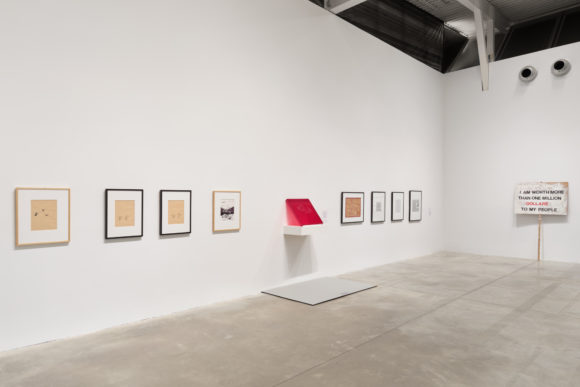
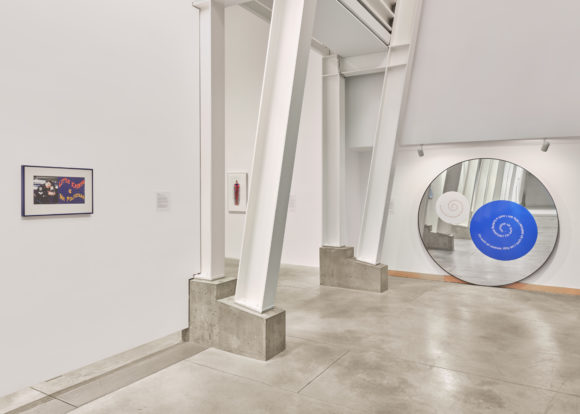
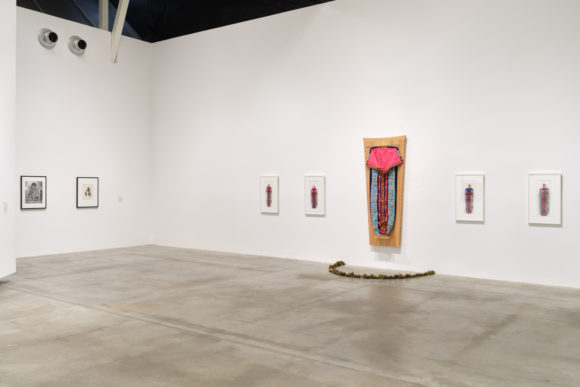
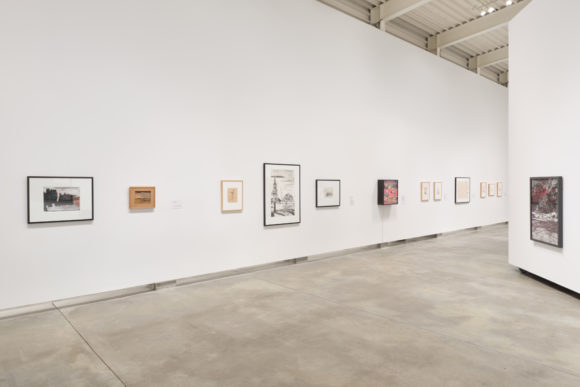

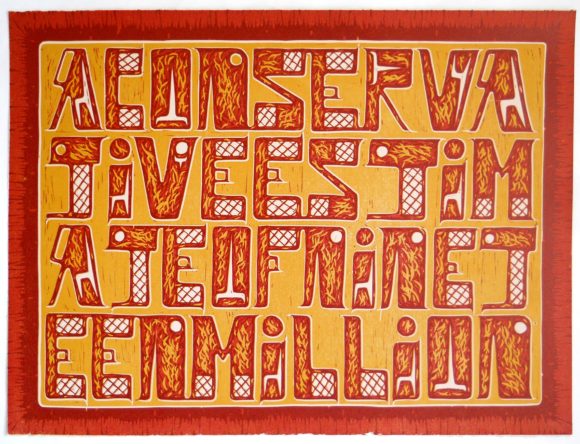
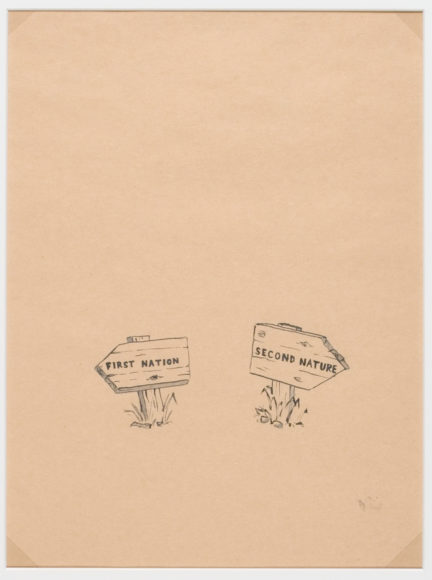
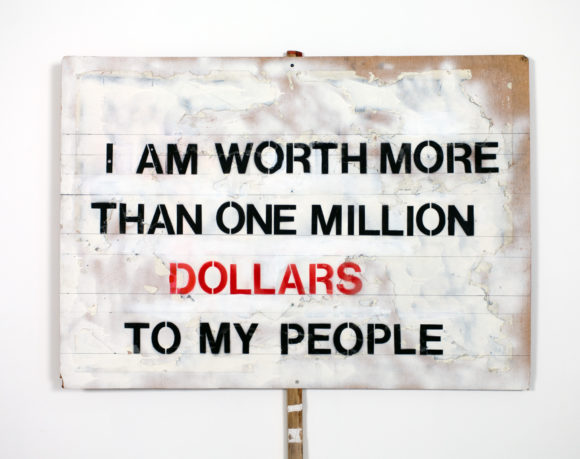
Image (above): Krista Belle Stewart, Seraphine, Seraphine (still), 2015. Collection of the Morris and Helen Belkin Art Gallery, purchased with support from the Canada Council for the Arts and the Morris and Helen Belkin Foundation, 2018
-
Marian Penner Bancroft
ArtistMarian Penner Bancroft (Canadian, b. 1947) is a Vancouver-based photographer and visual artist and Professor Emerita at Emily Carr University of Art and Design. While multifaceted and ever evolving, her practice has largely centered on the intersection between socio-cultural history, personal memory and photography. More recently, Bancroft’s work has focused on investigating the relationship between photographic images, history, music and mapping strategies in terms of their capacity to represent landscapes. Bancroft studied at UBC, the Vancouver School of Art and Ryerson Polytechnical Institute. Bancroft has exhibited extensively in solo exhibitions at the Vancouver Art Gallery, Catriona Jeffries Gallery, Republic Gallery, Galerie de l’UQAM, Or Gallery and Presentation House Gallery. She has been featured in group exhibitions including C. 1983 (2012) at Presentation House Gallery, North Vancouver; SLOW: Relations + Practices (2010) at Centre A, Vancouver and Wack: Art And The Feminist Revolution (2008) at the Vancouver Art Gallery. Bancroft has won numerous awards including the Audain Prize for Lifetime Achievement in the Visual Arts (2012), the Higashikawa Award for photographic Achievements (2018) and the Canada Council Paris Studio Residency Award (2005).
Read More
-
Rebecca Belmore
ArtistRebecca Belmore (Lac Seul First Nation (Anishinaabe), b. 1960) is a multidisciplinary visual artist. Belmore is widely recognized for her performance, photographic and sculptural work that makes connections between bodies, land and language with ongoing social and political realities faced by Indigenous communities. Questions of authority, narrative and truth resonate throughout her practice. In 2005 she was the first Indigenous woman to represent Canada in the Venice Biennale. Her work has appeared extensively in exhibitions both nationally and internationally, and her solo exhibitions include the Belkin Art Gallery, Art Gallery of Ontario, and Justina M. Barnick Gallery. Belmore has received numerous honours and awards, including the Hnatyshyn Award (2009), the Governor General’s Award for Visual and Media Arts (2013) and Gershon Iskowitz Prize (2016). She attended the Ontario College of Art and Design in Toronto, and has received honourary doctorates from OCAD University (2005), Emily Carr University of Art and Design (2018), and NSCAD University (2019).
Read More
-
Judith Copithorne
ArtistJudith Copithorne (Canadian, b. 1939) is one of Vancouver’s most influential concrete poets. Copithorne’s “poem-drawings” employ abstract lines and words to create a visual work of art, a reference to concrete poetry’s emphasis on typographical effects rather than verbal importance. Her work from the 1960s and 1970s engages with meditation and community, referring to mandalas, maps and yogic texts. Her work has expanded, including explorations into digital means of composing poem-drawings, creating crisp and over saturated drawings with texts. Copithorne’s practice in concrete poetry and other forms of experimental writing led to her social and artistic participation at Sound Gallery, Motion Studio and Intermedia in Vancouver. She worked alongside many artist-poets, taking part in Downtown Vancouver Poets, an informal group imagined as a counterpoint to those involved at TISH, a Canadian poetry newsletter run by student-poets at the University of British Columbia in 1961. Copithorne has an extensive list of publications including over 40 books, chapbooks and ephemeral items.
Read More
-
Audrey Capel Doray
ArtistAudrey Capel Doray (b. 1931) is a Canadian artist working in a variety of mediums—painting, printmaking, electronic art, murals and films. She received a BFA from McGill University and went on to study at Atelier 17 in Paris and at the Central School of Art in London. After moving to Vancouver in 1957, Capel Doray taught at the Vancouver School of Art (now Emily Carr University) from 1959 to 1961. In 1962, Capel Doray joined Alvin Balkind and Abraham Rogatnick’s New Design Gallery, an influential art space that presented live theatre, visual art, films, concerts, lectures and poetry readings. Capel Doray was a major figure in the Vancouver scene of the 1960s and was engaged with experiments in new media, interactive and kinetic art and electronic communications. She and her late husband, Victor Doray, were community leaders, involving themselves in Intermedia and other experimental formations influenced by philosopher Marshall McLuhan. A recipient of four Canada Council awards, Capel Doray’s work is held in numerous private and public collections, both nationally and internationally. Her work is described in North American Women Artists of the Twentieth Century as combining “robust social criticism with her own interpretation of humanist theory” and dealing with pop art and the feminist archetype, themes of “perpetual motion and endless transition”, and the interplay of sound and light.
Read More
-
Whess Harman
ArtistWhess Harman (Carrier Wit’at, b. 1974) is an artist whose multidisciplinary practice encompasses beadwork, illustration, text, poetry and curation. Through humour and carefully negotiated cynicism, their work navigates “undiagnosed attention deficit disorder, colonial bullshit and queer melancholy” as it is experienced through their identity as a mixed-race, transgender artist. Their practice emphasizes the importance of community-engaged work and the need to prioritize accessible and safe spaces. In January 2021, Harman became the curator of grunt gallery in Vancouver. They received their BFA from Emily Carr University of Art and Design (2014). Solo exhibitions include chew the bones, they’re soft at Open Space, Victoria (2022) and Lossy: How to Save File for Future Transmission at the Fina Gallery at the University of British Columbia Okanagan, Kelowna (2021). Group exhibitions include Sensing of the Wound at the Or Gallery, Vancouver (2022); Nch’u7mut cheshá7 temíxw/Giving Back to Mother Earth at the Talking Stick Festival, Vancouver (2021); gathered together at the Wall-to-Wall Mural Festival, Winnipeg (2021); Distortions and Echo at the Vancouver Art Gallery (2021); Exploring Care at the Campbell River Art Gallery (2021); On Beaded Ground at the Legacy Art Gallery, Victoria (2021); cause to become at the School of Art, Winnipeg (2021); and queersphere at InterAccess, Toronto (2021) among others. Their curatorial projects include Together Apart, Queer Indigeneities at grunt gallery (2019); Spark Talks at grunt gallery (2018) and The Tribe Has Spoken at Skwachay’s Lodge, Vancouver (2018).
Read More
-
Brian Jungen
ArtistBrian Jungen (Dane-zaa, b.1970) is a visual artist of Dane-zaa and Swiss-German ancestry. In his artistic practice, Jungen addresses complex relationships between Indigenous and global cultures through the juxtaposition of cultural signifiers. Jungen incorporates visual elements from both western consumer culture and motifs drawn from Indigenous traditions, a reflection of his mixed heritage. This hybridization of identities—present through most of Jungen’s oeuvre, from small-scale drawings to large-scale sculptures and installations— queries relationships of aesthetic, economic and social power at personal and global scales. Jungen has participated in group exhibitions including Baja to Vancouver: The West Coast in Contemporary Art, Museum of Contemporary Art San Diego (2004) and What Water Knows, The Land Remembers, Toronto Biennial of Art (2022). Jungen has held solo exhibitions with Or Gallery, Vancouver (2000); documenta 13 (in collaboration with Duane Linklater), Kassel, Germany (2013), the Art Gallery of Ontario, Toronto (2019) and the Hammer Museum, Los Angeles (2021). He currently lives and works in the North Okanagan region of BC.
Read More
-
Rita Letendre
ArtistRita Letendre (Abenaki/Quedecoise, 1928-2021) was an internationally renowned painter, printmaker and muralist. She began her career in the 1950s in Montreal, working in abstraction and associating with Les Automatistes and Les Plasticiens, often being the only woman in their group exhibitions. Her abstract works employ vibrant oils which suggest movement through repeated geometric shapes. Letendre gradually moved from the looser Automatiste style to the more geometric, hard-edged techniques employed by the Plasticiens. In 1948, Letendre enrolled at the École des Beaux-Arts in Montreal, but did not agree with their strong emphasis on traditional figurative art, which brought her into conversation with Les Automatistes and Les Plasticiens. She caught the attention of the wider Canadian abstract art scene in 1954 when she was included in the Automatiste exhibition La matière chante in 1954. Letendre visited California in the mid-1960s, where she attended the Tamarind Lithography Workshop and produced her first prints in 1965. In 2005, she received the Order of Canada and in 2010, the Governor General’s Award in Visual and Media Arts.
Read More
-
Ken Lum
ArtistKen Lum (Canadian, b. 1956) is an artist with an extensive international exhibition record. He co-founded and served as the founding editor of the Yishu Journal of Contemporary Chinese Art. A prolific writer, he has published numerous essays. He has delivered keynote addresses at various prestigious events, including the 2024 Duldig Sculpture Lecture in Melbourne, the 2022 International Association of Empirical Aesthetics Congress in Philadelphia, and the 2010 World Museums Conference in Shanghai. His writings are compiled in Everything is Relevant: Writings on Art and Life 1991 – 2018, published by Concordia University Press in 2020. Lum has completed many public art commissions in cities such as Rotterdam, Leiden, St. Louis, Toronto, St. Moritz, and Vienna. He co-curated exhibitions, including Shanghai Modern: 1919 – 1945, Sharjah Biennial 7, and Monument Lab: Creative Speculations for Philadelphia. Additionally, Lum is a co-founder and serves as the Senior Curatorial Advisor to Monument Lab, a public art and history think tank in Philadelphia. He holds the Marilyn Jordan Taylor Presidential Professorship at the University of Pennsylvania.
Read More
-
Salar Mameni
ArtistSalar Mameni (Canadian, b.1977) is an interdisciplinary artist, curator and art historian specializing in transnational visual culture in the Arab/Muslim world. Their research areas include racial discourses, feminism and gender politics, militarism, extractive economies, oil cultures and the anthropocene. Mameni’s newspaper drawings replicate the everyday, an acknowledgement of the mass consumption of media but also of the tedious labour involved in the manual reproduction of mass media. Mameni received a BFA from Emily Carr University of Art and Design, an MFA from the University of British Columbia and a PhD in Art History from the University of California, San Diego. They have written for Signs, Women & Performance, Al-Raida Journal, Fuse Magazine, Fillip Review and Canadian Art Journal. Their work has been exhibited in group exhibitions at Atelier Gallery, Vancouver (2003); the Vancouver Art Gallery (2003, 2012); YYZ Artists’ Outlet, Toronto (2008) and Western Front, Vancouver (2008). Mameni is Assistant Professor in the Department of Ethnic Studies, University of California, Berkeley. They are currently working on their first book, Crude: The Art of Living in the Terracene.
Read More
-
Melinda Mollineaux
ArtistMelinda Mollineaux (Canadian, b. 1964) is a visual artist who investigates Blackness, the diaspora and visibility in her artistic practice. Born in London, England, her parents migrated from Trinidad to Britain in the 1950s and settled in Lethbridge, AB in 1981. Mollineaux explores identities formed in the Black diaspora, bringing forth its invisible qualities through pinhole photography and ceramics. Focused on time and presence, she foregrounds her own body through the process of slow photography to call attention to the erasure of Black people within Canadian cultural discourses. Mollineaux received a BA from Simon Fraser University and an MFA in photography from the University of Victoria. She was active in Vancouver’s artist-run centres and was co-editor of Boo Magazine in the 1990s. Mollineaux works at the Canada Council for the Arts as a Policy and Planning Officer, prior to which she held roles as Program Officer and Equity Coordinator; in the latter role, Mollineaux oversaw cultural diversity-related policies and initiatives, ensuring visible minority artists and organizations have equal access to the Council’s funding programs.
Read More
-
Marianne Nicolson
ArtistMarianne Nicolson (Kwakwa̱ka̱’wakw, Musga̱maḵw Dzawada̱’enux̱w First Nations, b. 1969) is an artist and activist of the Musga̱maḵw Dzawada̱’enux̱w Nations who are part of the Kwakwa̱ka̱’wakw (Kwak’wala speaking peoples) of the Northwest Coast. She is trained in both traditional Kwakwa̱ka̱’wakw forms and culture and contemporary gallery and museum-based practice. Her practice is multi-disciplinary, encompassing photography, painting, carving, video, installation, monumental public art, writing and speaking. She works as a Kwakwaka’wakw cultural researcher and historian, as well as an advocate for Indigenous land rights. She holds a BFA from the Emily Carr University of Art and Design (1996), an MFA (2000), MA in Linguistics and Anthropology (2005) and PhD in Linguistics and Anthropology with a focus on space as expressed in the Kwak’wala language (2013) all from the University of Victoria. Solo exhibitions include the Art Gallery of Greater Victoria (2008); Artspeak, Vancouver (2006); Esquimalt Municipal Hall (2004); Thunder Bay Art Gallery (2002); National Indian Art Centre, Hull (2001); Campbell River Public Art Gallery (2000) and Or Gallery, Vancouver (1992). Group exhibitions include the 17th Biennale of Sydney (2020); the Morris and Helen Belkin Art Gallery, Vancouver (2020); the Vancouver Art Gallery (2019-20); the National Gallery of Canada, Ottawa (2018-19) and the National Museum of the American Indian, New York (2017-19), among others. Major monumental public artworks are situated in her home territory of the Musga̱maḵw Dzawada̱’enux̱w First Nation, Vancouver International Airport, the Canadian Embassy in Amman, Jordan and the Canadian Embassy in Paris, France.
Following Nicolson’s Hexsa’a̱m: To Be Here Always, a 2019 project with the Belkin that functioned as research, material, media, testimony and ceremony to challenge the western concept that the power of art as limited to the symbolic, This Is An Emergency Broadcast (2023) is another moment to amplify Indigenous tradition.
Read More
-
Jeneen Frei Njootli
ArtistJeneen Frei Njootli (Vuntut Gwitchin, b. 1988) is a 2SQ artist currently based in their home territory of Old Crow, YT. Their work with knowledge keepers has guided their interdisciplinary practice which is grounded in affirming Indigenous sovereignty, decolonization and considering the ways in which images are created, shared and embodied. Through an interdisciplinary practice encompassing performance, photography, sound, textiles, workshops and collaboration, they seek to deconstruct the history of materials and to investigate their relationship to the land, trade, ceremony and politics of Indigenous representation. Njootli received an MFA from the University of British Columbia (2017) and a BFA from Emily Carr University of Art and Design (2012). Solo exhibitions include the PLATFORM Centre, Winnipeg (2020), Remai Modern, Saskatoon (2019), Contemporary Art Gallery, Vancouver (2018); Artspace, Vancouver (2018); Southern Alberta Art Gallery, Lethbridge (2017) and Definitely Superior Art Gallery, Thunder Bay (2017). Their work has been exhibited in group exhibitions including at the New Museum Triennial, New York (2021), the Anchorage Museum (2021), the Vancouver Art Gallery (2020) and the National Gallery of Canada, Ottawa (2018-19). Njootli was shortlisted for the Sobey Art Award (2018) and received the Contemporary Art Society Vancouver Artist Prize (2017). They are a founding member of the ReMatriate Collective (created in 2015), which engages social media as a way of bringing Indigenous women together through art.
Read More
-
Jerry Pethick
ArtistJerry Pethick (Canadian, 1935-2003) was a visual artist who bridged artistic and scientific fields through an immersive study of optics and perception. Pethick’s lifelong interest in technology and the possibilities of visual perception led to experiments with unconventional materials in his art practice such as plastics and lenticular lenses. A key strategy in his experimentation was obscuring perspective, either through lenses or sculptural assemblages, which was reflective of his critique of modernism and linear progress. Pethick’s work gained popularity during the 1960s and 1970s, as it aligned with many counterculture concepts including alternative experiences of reality, op-art and mysticism. A graduate of Chelsea Polytechnic and the Royal College of Art in London, UK, Pethick’s work has been exhibited internationally, including shows at the Vancouver Art Gallery (1979, 1984), the National Gallery of Canada, Ottawa (1989), Centre International d’Art Contemporain Montréal (1992) and the Toronto Sculpture Garden (1993). A major survey of his work was exhibited posthumously at the Vancouver Art Gallery in 2015.
Read More
-
ᐃᓄᒡᔪᐊᕐᔪᒃ ᐳᓪᓚᑦ Innukjuakju Pudlat
Artistᐃᓄᒡᔪᐊᕐᔪᒃ ᐳᓪᓚᑦ Innukjuakju Pudlat (Inuk, 1913-1972) is a visual artist who grew up in the Kiaktuuq region of Nunavut. After marrying artist Pudlo Pudlat, she moved to Amadjuak and later to Kinngait (formerly Cape Dorset). Pudlat worked primarily in drawing and printmaking to depict histories, contemporary realities and cultural knowledge from the worldviews of the Inuit living in Baffin Island. She produced numerous textile works alongside a group of Inuit artists and printmakers as part of Kinngait Studios (formerly known as the West Baffin Eskimo Co-operative) from the 1950s to 1960s. In 1959, five of her prints were included in the inaugural Cape Dorset Print Collection and in 1983, one of her prints was featured on the cover of a UNICEF greeting card. Her work has been exhibited at the Textile Museum of Canada, Toronto (2019-22); McMichael Art Gallery, Kleinburg (2013); Memorial Art Gallery, Rochester (2009-10); Arctic Artistry in Hastings-on-Hudson (1990); Glenbow Museum, Calgary (1990); University of Michigan, Ann Arbor (1987-89); Macdonald Stewart Art Centre, Guelph (1987); Simon Fraser University Gallery, Burnaby (1971) and Konstframjandet, Stockholm (1967), among others. Her work resides in the collections of the National Gallery of Canada, Ottawa; the Museum of History, Hull; the Glenbow Museum, Calgary; West Baffin Eskimo Cooperative, Kinngait; Laurentian University Museum and Arts Centre, Sudbury; Winnipeg Art Gallery; Royal Ontario Museum, Toronto, among many others.
Read More
-
Skeena Reece
ArtistSkeena Reece (Tsimshian/Gitksan/Cree, b. 1974) is an artist based on the West Coast of British Columbia. Her installation and performance work has garnered national and international attention, most notably for Raven: On the Colonial Fleet (2010) presented at the 2010 Sydney Biennale as part of the group exhibition Beat Nation. Her multi-disciplinary practice includes performance art, spoken word, humour, “sacred clowning,” writing, singing, songwriting, video and visual art. She studied media arts at Emily Carr University of Art and Design, and was the recipient of the British Columbia Award for Excellence in the Arts (2012), the VIVA Award (2014) and the Hnatyshyn Award (2017). For Savage (2010), Reece won a Genie Award for Best Acting in a Short Film and the film won a Golden Sheaf Award for Best Multicultural Film, ReelWorld Outstanding Canadian Short Film, Leo Awards for Best Actress and Best Editing. Solo exhibitions include Surrounded at the Morris and Helen Belkin Art Gallery (2019); Touch Me at the Comox Valley Art Gallery, Courtenay, BC (2018); Moss at Oboro Gallery, Montréal (2017) and The Sacred Clown & Other Strangers at Urban Shaman Contemporary Aboriginal Art, Winnipeg (2015). Group Exhibitions include Red on Red: Indigeneity, Labour, Value at the University of British Columbia, Vancouver (2022); Women & Masks: An Arts-Based Research Conference at Boston University (2021-22), Interior Infinite at the Polygon Gallery, North Vancouver (2021); Àbadakone at the National Gallery of Canada, Ottawa (2018-2019) and Sweetgrass and Honey at Plug In ICA, Winnipeg (2018), among others.
Read More
-
Krista Belle Stewart
Curator, ArtistKrista Belle Stewart (Syilx Nation, b. 1979) is a visual artist and citizen of the Syilx Nation currently based in Berlin and Vienna. Stewart works primarily with video, photography, sculpture and performance, drawing out personal and political narratives inherent in archival materials while questioning their articulation in institutional histories. Her work has been shown at solo exhibitions at Goethe Institute Seattle (2021); MOCA, Toronto (2020); Nanaimo Art Gallery (2019); Kunstlerhaus Bethanien, Berlin (2019); Teck Gallery at Simon Fraser University, Vancouver (2018) and Mercer Union as part of the 28th Images Festival, Toronto (2015). Group exhibitions include Kunstverein in Hamburg (2021); Eva International, Limerick (2021); Bonniers Konsthall, Stockholm (2020); CTM Festival, Berlin (2020); ISCP, Brooklyn (2017); Musée d’Art Contemporain, Montreal (2017) and Vancouver Art Gallery (2016). Screenings and performances include Haus der Kulturen der Welt, Berlin (2022 and 2017); MoMA’s Doc Fortnight, Manhattan (2021); UnionDocs, Brooklyn (2019); 221A, Vancouver (2018) and Plug-In Institute, Winnipeg (2017). Stewart’s work is currently part of Galerie Barbara Thumm’s online platform New Viewings. She is an MFA graduate from the Milton Avery Graduate School of the Arts at Bard College, Annandale-On-Hudson, NY and is presently a PhD in Practice candidate at the Academy of Fine Arts in Vienna, Austria.
Read More
-
Althea Thauberger
ArtistThauberger is an artist and filmmaker and an Associate Professor of Visual Art at the University of British Columbia. Her artistic work involves collaborative research and is primarily concerned with the relationship between community narratives and geopolitical histories. Thauberger has produced and exhibited her work internationally including recent exhibitions at the Contemporary Art Gallery in Vancouver and the Kaunas Biennial in Lithuania.
Read More
-
Joyce Wieland
ArtistJoyce Wieland (Canadian, 1931-1998) was an artist and experimental filmmaker celebrated for bringing feminist concerns to the forefront of Canadian art in the 1960s and 1970s. Drawing inspiration from Canadian history, politics and ecology, Wieland’s career as an artist began in painting with her first solo exhibition in 1960 at the Isaacs Gallery in Toronto. After relocating to New York in 1962, she became widely known for experimental video work, including her innovative approach to gender and landscape in The Far Shore (1976), a feminist re-imagining of the story of the Canadian painter Tom Thomson. Following her return to Canada in 1971, Wieland’s work began to challenge modernist ideals by incorporating traditionally feminine materials, such as sewing, knitting, rug hooking and embroidery. In 1971, Wieland opened True Patriot Love, the first retrospective for a living Canadian woman artist at the National Gallery of Canada. In 1987, the Art Gallery of Ontario mounted a major travelling exhibition of Wieland’s work, which was also its first retrospective of a living Canadian woman artist. Joyce Wieland was a member of the Royal Canadian Academy of Arts and was made an Officer of the Order of Canada in 1982.
Read More
-
Lawrence Paul Yuxweluptun Lets’lo:tseltun
ArtistLawrence Paul Yuxweluptun Lets’lo:tseltun (Cowichan/Syilx, b. 1957) is a Vancouver-based visual artist and activist of Cowichan (Hul’q’umi’num Coast Salish) and Okanagan (Syilx) descent. Born in Kamloops, BC, he attended the Kamloops Indian Residential School as a child, but spent most of his adolescence in the Vancouver area. He documents and promotes change in contemporary Indigenous history through his paintings using Coast Salish cosmology, Northwest Coast formal design elements and the western landscape tradition. His work explores political, environmental and cultural issues and his own personal and socio-political experiences enhance this practice of documentation. Yuxweluptun has exhibited nationally and internationally in solo and group shows, including the Belkin’s inaugural 1995 exhibition Lawrence Paul Yuxweluptun: Born to Live and Die on Your Colonialist Reservations, the Museum of Anthropology’s Lawrence Paul Yuxweluptun: Unceded Territories (2016), the National Gallery of Canada’s Sakahán: International Indigenous Art (2013), and the Services Culturels de l’Ambassade du Canada’s Inherent Rights, Vision Rights: Virtual Reality Paintings and Drawings (1993). Yuxweluptun has received numerous awards, including the Vancouver Institute of the Visual Arts (VIVA) Award in 1998 and the Eitelijorg Museum of American Indians and Western Art Fellowship in 2013. His paintings are held in the collections of the Vancouver Art Gallery, the Canadian Museum of Civilization (Gatineau, GC), the Department of Indian and Northern Affairs and the National Gallery of Canada. The name Yuxweluptun was given to the artist during his initiation into the Sxwaixwe Society at age 14 and is Salish for “man of many masks”; the name Lets’lo:tseltun was given to the artist by Sto:lo artist Laura Wee Lay Laq in 2018 and means “man of many colours.”
Read More
-
Melanie O’Brian
CuratorMelanie O’Brian is Associate Director/Curator at the Belkin, and has been the gallery’s Acting Director/Curator 2022 to the present. Prior to joining the Belkin, O’Brian was Director/Curator of Simon Fraser University Art Galleries, including Audain, Teck and SFU Gallery, from 2012 to 2020. She was formerly Curator/Head of Programs at The Power Plant Contemporary Art Gallery in Toronto, Director/Curator at Artspeak in Vancouver and Assistant Curator at the Vancouver Art Gallery. O’Brian has taught at UBC, Emily Carr University and Simon Fraser University, and received her MA in Art History from the University of Chicago. She has organized exhibitions locally and internationally, edited numerous publications and written extensively for catalogues and magazines.
Read More
Related
-
Event
Saturday, 18 Jun 2022 at 2 pm
Curators’ Tour: Start Somewhere Else with Melanie O’Brian and Krista Belle Stewart

Join curators Melanie O'Brian and Krista Belle Stewart for a tour of Start Somewhere Else: Works from the Collection, which centres around Stewart's video installation Seraphine, Seraphine (2015) to consider doubling – and duplicities – in personal and historical narratives. O'Brian and Stewart will walk through the exhibition and offer insights into the themes, conversations and points of resonance between Stewart's and the other works drawn from the Belkin's permanent collection.
[more] -
News
14 Jun 2022
Reading Room: Start Somewhere Else

Start Somewhere Else: Works from the Collection centres around Krista Belle Stewart’s video installation Seraphine, Seraphine (2015) to consider doubling – and duplicities – in personal and historical narratives. Connecting to Stewart’s questioning of authorial representation and intention versus interpretation of archival materials, Start Somewhere Else considers how stories are told between the individual and institution. The list below includes readings expanding on themes and ideas in the exhibition that were compiled by graduate and undergraduate researchers at the Belkin.
[more] -
Exhibition
16 Jun – 5 Sep 2022 from 9 am to 9 pm
Outdoor Screen: Marian Penner Bancroft’s the rifting of Pangaea
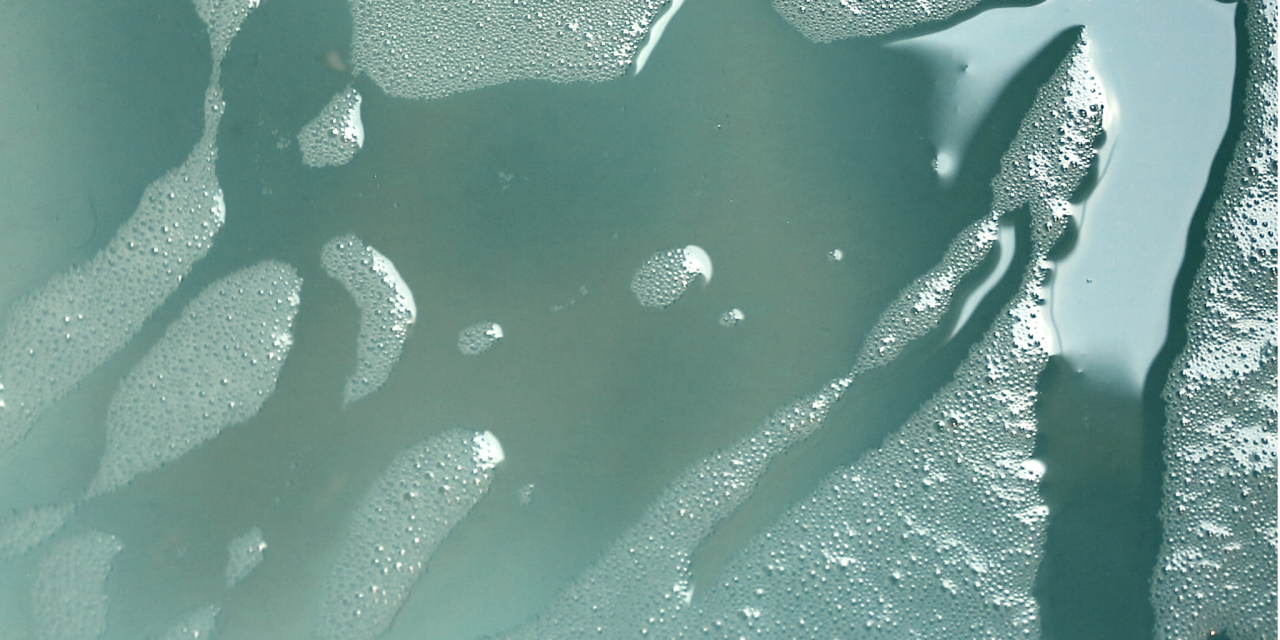
From June until August, the Belkin's outdoor screen will exhibit Marian Penner Bancroft's the rifting of Pangaea (2019) daily from 9 am until 9 pm. Evocative of breaking and shifting continents, the rifting of Pangaea takes a domestic view of large scale geologic and time changes.
[more] -
News
24 Jul 2020
Works from the Collection: Krista Belle Stewart
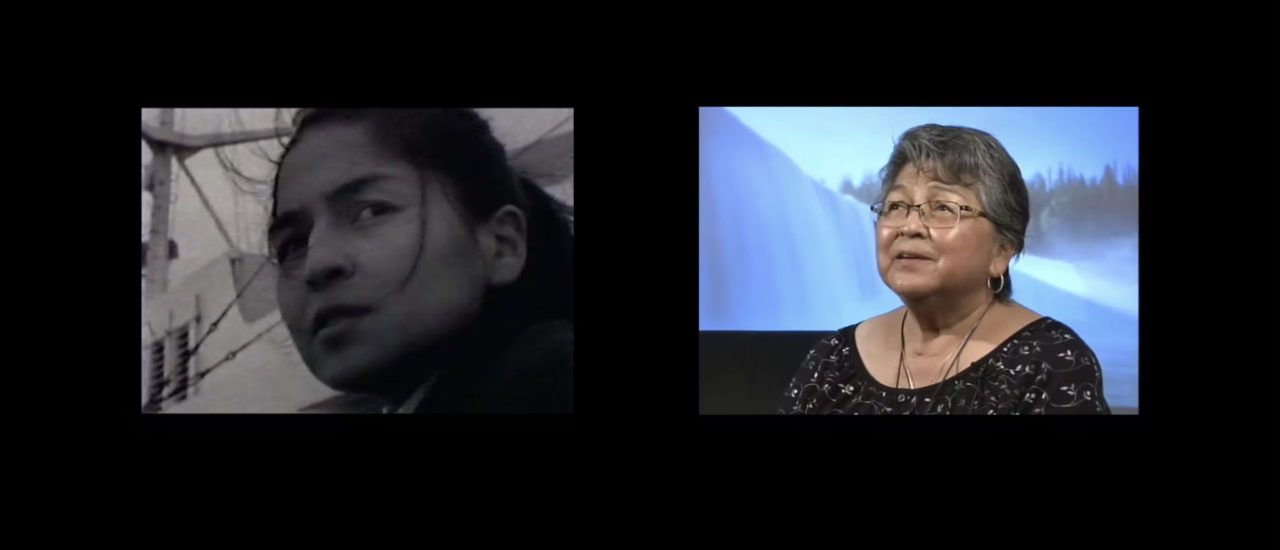
Karen Zalamea talks about Krista Belle Stewart's two-channel video, Seraphine, Seraphine (2015).
[more] -
Event
Artist Talk: Melinda Mollineaux

Melinda Mollineaux's Cadboro Bay presents photographic fragments of a site on Vancouver Island where Emancipation Day picnics were held every August 1. In this artist talk that took place during the exhibition Start Somewhere Else: Works from the Collection, Mollineaux discusses the visibility and erasures of Black lives and communities at Sungayka, her use of pinhole photography, and how Cadboro Bay continues to resonate through recent renewed interrogations into Canada's erasure of Black history.
[more]